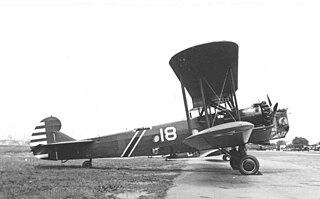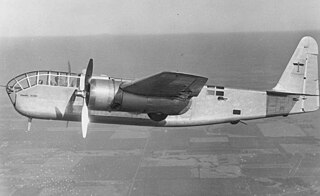
The North American B-25 Mitchell is a medium bomber that was introduced in 1941 and named in honor of Major General William "Billy" Mitchell, a pioneer of U.S. military aviation. Used by many Allied air forces, the B-25 served in every theater of World War II, and after the war ended, many remained in service, operating across four decades. Produced in numerous variants, nearly 10,000 B-25s were built. These included a few limited models such as the F-10 reconnaissance aircraft, the AT-24 crew trainers, and the United States Marine Corps' PBJ-1 patrol bomber.

The Martin B-10 was the first all-metal monoplane bomber to be regularly used by the United States Army Air Corps, entering service in June 1934. It was also the first mass-produced bomber whose performance was superior to that of the Army's pursuit aircraft of the time.

The Consolidated B-32 Dominator was an American heavy strategic bomber built for United States Army Air Forces during World War II, which had the distinction of being the last Allied aircraft to be engaged in combat during World War II. It was developed by Consolidated Aircraft in parallel with the Boeing B-29 Superfortress as a fallback design should the B-29 prove unsuccessful. The B-32 only reached units in the Pacific during mid-1945, and subsequently saw only limited combat operations against Japanese targets before the end of the war. Most of the extant orders of the B-32 were canceled shortly thereafter and only 118 B-32 airframes of all types were built.

The Douglas A-20 Havoc is an American medium bomber, attack aircraft, night intruder, night fighter, and reconnaissance aircraft of World War II.

The Boeing XB-15 was a United States bomber aircraft designed in 1934 as a test for the United States Army Air Corps (USAAC) to see if it would be possible to build a heavy bomber with a 5,000 mi (8,000 km) range. For a year beginning in mid-1935 it was designated the XBLR-1. When it first flew in 1937, it was the most massive and voluminous aircraft ever built in the US. It set a number of load-to-altitude records for land-based aircraft, including carrying a 31,205 lb (14,154 kg) payload to 8,200 ft (2,500 m) on 30 July 1939.

The Keystone B-6 was a biplane bomber developed by the Keystone Aircraft company for the United States Army Air Corps.
The Martin XB-16, company designation Model 145, was a projected heavy bomber designed in the United States during the 1930s.

The North American XB-21, also known by the manufacturer's model designation NA-21, and sometimes referred to by the name "Dragon", was a prototype bomber aircraft developed by North American Aviation in the late 1930s, for evaluation by the United States Army Air Corps. Evaluated against the Douglas B-18 Bolo, it was found to be considerably more expensive than the rival aircraft, and despite the ordering of a small number of evaluation aircraft, only the prototype was ever built.

The Douglas B-23 Dragon is an American twin-engined bomber developed by the Douglas Aircraft Company as a successor to the B-18 Bolo.
The Martin XB-27 was an aircraft proposed by the Glenn L. Martin Company to fill a strong need in the United States Army Air Corps for a high-altitude medium bomber. Its design was based approximately on that of Martin's own B-26 Marauder. The XB-27 remained on paper, and no prototypes were built.

The North American XB-28 (NA-63) Dragon was an aircraft proposed by North American Aviation to fill a strong need in the United States Army Air Corps for a high-altitude medium bomber. It never entered production, with only two prototypes being built.

The Lockheed XB-30 was the design submitted by Lockheed after the request by the United States Army Air Forces for a very heavy bomber, the same request that led to the Boeing B-29 Superfortress, the Douglas XB-31 and Consolidated B-32 Dominator.
The Douglas XB-31 was the design submitted by Douglas after the request by the United States Army Air Forces for a very heavy bomber aircraft, the same request that led to the Boeing B-29 Superfortress, Lockheed XB-30, and Consolidated B-32 Dominator.
The Martin B-33 was a World War II American bomber aircraft. It was designed by the Glenn L. Martin Company as the Martin Model 190 and was a high-altitude derivative of the company's B-26 Marauder. Two different designs were developed, first as a twin-engined aircraft and then as a four-engined aircraft. The four-engined version was ordered by the United States Army Air Forces, but the program was cancelled before any aircraft were built.

The Boeing YB-9 was the first all-metal monoplane bomber aircraft designed for the United States Army Air Corps. The YB-9 was an enlarged alteration of Boeing's Model 200 Monomail commercial transport.

The Vultee V-11 and V-12 were American stressed-skin monocoque monoplane attack aircraft of the 1930s. Developed from the Vultee V-1 single-engined airliner, the V-11 and V-12 were purchased by several nation for their armed forces, including China, who used them in combat against Japanese forces in the Second Sino-Japanese War. The United States Army Air Corps purchased seven V-11s as the YA-19 in the years before World War II, testing them to gather data to compare against twin engine light attack aircraft.

The Stearman XA-21 was a competitor in a United States Army Air Corps competition for a twin-engined attack aircraft which led to the Douglas A-20 Havoc, Martin A-22 Maryland and North American B-25 Mitchell.

The Grumman XSBF, also known by the company designation G-14, was an American biplane scout bomber developed by Grumman Aircraft for the United States Navy during the 1930s. Derived from Grumman's successful "Fifi" fighter, the aircraft was developed at a time when the biplane was giving way to the monoplane. In competition against other aircraft it proved to possess inferior performance in its intended role, and did not enter production. The sole prototype went on to serve as a liaison aircraft, as well as being used in experiments by NACA, before being destroyed in a crash in 1939.

The Keystone LB-6 and LB-7 were 1920s American light bombers, built by the Keystone Aircraft company for the United States Army Air Corps, called Panther by the company, but adoption of the name was rejected by the U.S. Army.
The Douglas Model 423 was a bomber aircraft design developed by American aircraft manufacturer Douglas to compete with the Convair B-36 design for a major U.S. Army Air Force contract for an intercontinental bomber in 1941. Although identified as the Douglas XB-31 in some publications, the project documents indicate that it was designed much later than the R40-B competition.

















